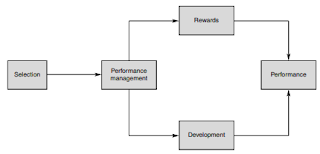Models of Human Resource Management
The Matching Model of Human Resource Management
One
of the first explicit statements of the HRM concept was made by the Michigan
School (Fombrun et al, 1984). They held that HR systems and the organization
structure should be managed in a way that is congruent with organizational
strategy (hence the name ‘matching model’). They further explained that there
is a human resource cycle (an adaptation of which is illustrated in Figure
1.2), which consists of four generic processes or functions that are performed
in all organizations. These are:
 |
| Human Resource Management Activities |
- Selection – matching available human resources to jobs;
- Appraisal – performance management;
- Rewards – ‘the reward system is one of the most under-utilized and mishandled managerial tools for driving organizational performance’; it must reward short as well as long-term achievements, bearing in mind that ‘business must perform in the present to succeed in the future’;
- Development – developing high quality employees.
 |
| The Human Resource Cycle (adapted from Fombrun et al, 1984) |
The
Harvard Framework
The
other founding fathers of HRM were the Harvard School of Beer et al (1984) who
developed what Boxall (1992) calls the ‘Harvard framework’. This framework is
based on the belief that the problems of historical personnel management can
only be solved:
When
general managers develop a viewpoint of how they wish to see employees involved
in and developed by the enterprise, and of what HRM policies and practices may
achieve those goals. Without either a central philosophy or a strategic vision
– which can be provided only by general managers – HRM is likely to remain a
set of independent activities, each guided by its own practice tradition.
Beer
and his colleagues believed that ‘Today, many pressures are demanding a
broader, more comprehensive and more strategic perspective with regard to the
organization’s human resources.’ These pressures have created a need for: ‘A
longer-term perspective in managing people and consideration of people as
potential assets rather than merely a variable cost.’ They were the first to
underline the HRM tenet that it belongs to line managers. They also stated
that: ‘Human resource management involves all management decisions and action
that affect the nature of the relationship between the organization and its
employees – its human resources.
The Harvard school suggested that HRM had two characteristic features: 1) line managers accept more responsibility for ensuring the alignment of competitive strategy and personnel policies; 2) personnel has the mission of setting policies that govern how personnel activities are developed and implemented in ways that make them more mutually reinforcing.
 |
| The Harvard Framework for Human Resource Management (Source: Beer et al, 1984) |
According to Boxall (1992) the advantages of this model are that it:
- Incorporates recognition of a range of stakeholder interests;
- Recognizes the importance of ‘trade-offs’, either explicitly or implicitly, between the interests of owners and those of employees as well as between various interest groups;
- Widens the context of HRM to include ‘employee influence’, the organization of work and the associated question of supervisory style;
- Acknowledges a broad range of contextual influences on management’s choice of strategy, suggesting a meshing of both product-market and socio-cultural logics;
- Emphasizes strategic choice – it is not driven by situational or environmental determinism.
